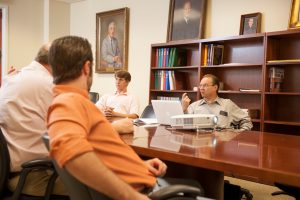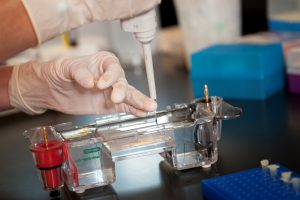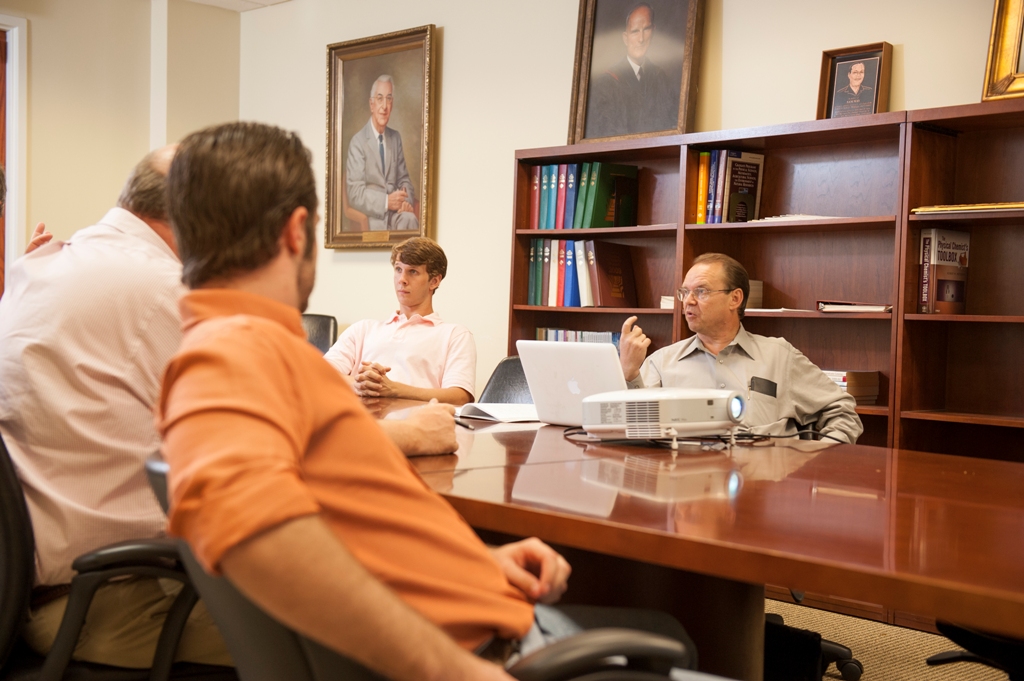By Chris Bryant
Photos by Jeff Hanson and Bryan Hester

As anyone who has picked up a newspaper – or stood in an unemployment line – knows, creating jobs in today’s economic climate is a slow-lane struggle.
“More and more pressure is being put on universities to be the engine to help propel that movement,” says Dr. Richard Swatloski, director of The University of Alabama’s Office for Technology Transfer.
UA’s OTT office, along with its Alabama Innovation and Mentoring of Entrepreneurs program, partners with faculty and staff researchers to bring technologies created at the University to the market place for public benefit. While the successful product, itself, by its very definition, brings public benefit, the potential jobs resulting from a new product or technology’s launch is, perhaps, equally important.
“We’ve got a lot of faculty who are very entrepreneurial,” Swatloski says. “It’s wide open.”
One of those entrepreneurial-minded faculty members is Dr. Martin Bakker, an associate professor of chemistry.
His research team, which also includes Franchessa Sayler, a UA graduate student serving as the team’s entrepreneurial lead, and Chris Melton, chief executive officer of White Oak Group Inc., an Atlanta-based private equity company, recently won a $50,000 National Science Foundation Innovation Corps, or I-Corps, grant.

The grants are designed to take discoveries made through earlier NSF-funded research projects and evaluate their potential as springboards to forming start-up companies. Bakker’s team focuses on its development of new types of catalysts – things that cause or accelerate chemical reactions.
It’s a big market. The types of catalysts Bakker’s team produces are referred to as palladium-supported on porous carbon catalysts. They make up, Bakker says, about one-third of all catalysts used in the annual $4.7 billion petrochemicals market. But, it’s also a tough market to break through. The College of Arts and Sciences’ chemist believes his team’s product has key attributes on its side.
“Our catalysts are cheaper, faster and have superior properties to those presently on the market,” he says. But, the trick to becoming commercially successful isn’t limited to only the building of a better mouse trap, he says. And it’s those other attributes needed for a marketable success to which researchers can turn to OTT and AIME .
“For those of us who come from academic backgrounds, this commercialization process is not something we have strong backgrounds in,” Bakker says. There is a pretty steep learning curve.”
Programs like the I-Corp grant, and UA’s two aforementioned offices, can soften that curve. Here’s how:
UA researchers file their research results or inventions through OTT’s disclosure form, starting the technology-triage process. With the assistance of student teams in AIME, each technology is assessed for patentability, related technology, additional potential applications for the idea, market size and projected growth and potential barriers to market entry.
UA’s 10-member Intellectual Property Committee, chaired by Swatloski, and an independent adviser panel then prioritizes the projects. This often times leads to the development of prototypes, business plans, the filing of patents, the search for investors and sometimes the licensing of the invention to off-campus entities.
AIME can also provide lab space, as it has to Bakker, from which companies can begin incubating prior to reaching full start-up phase.
“One area that I think is really important is prototype development,” says Dr. Dan Daly, director of AIME. “Most investors will not fund something unless they put their hands on it … look at it, feel it … rather than just read about it on a piece of paper. We will try to build a working prototype of the technology … using outside firms to help us in certain areas.”

AIME can also provide an experimental design study of products – statistically controlled bench markings, where a competitor’s product is purchased and compared to the UA discovery. This was done with Bakker’s catalysts with promising results, Daly said.
“We measured the reaction rates and showed that Martin’s is actually better.”
Over the last five years, 189 invention disclosures were submitted to the Office for Technology Transfer, resulting in the issuance of 68 patents, including 13 in the U.S., and UA has 13 active licensing agreements with external entities, according to OTT statistics.
As the number of technologies – and potential new jobs – coming forth from UA laboratories grows, Swatloski, says he’s actively searching for more management mentors from outside campus who are interested in bringing their business acumen to individual technology teams.
“I’m now getting to see 30 or 40 technological breakthroughs a year from all over campus – from engineering to library sciences,” Swatloski says. “That’s exciting.”
And the potential of turning those breakthroughs into future jobs is an exciting and productive step toward shifting out of the slow-lane job struggle.
